Sometimes the magic of children’s and young adult literature can be lost on adults. As we grow up and move on to adult novels and nonfiction, we tend to go straight to our section of interest in a bookstore or online. But what teachers can truly cherish is the opportunity to revisit old favorites and discover new titles every year, actually every week. Here are some of my recent discoveries.
Ages 4–8
Benny and Penny in How to Say Goodbye. Geoffrey Hayes. 2016. Toon/Raw Junior.
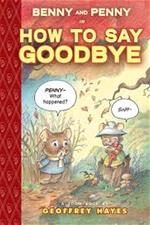 It’s never easy to deal with loss and saying goodbye to a loved one. In gentle, honest, and slightly humorous fashion, this graphic novel filled with softly colored pencil illustrations tackles those tough topics. While playing in the fall leaves, Penny, a bunny, finds the body of Little Red, her salamander friend. Not only is she upset about this unexpected discovery, but she is also surprised by the disinterest of her brother Benny, who shows a decided lack of compassion over the death. Penny and her friend Melina bury Little Red and have a little farewell ceremony. As they reminisce and start singing silly songs, Benny overhears them and feels guilty, prompting the two girls to suggest how he can atone for his misdeeds.
It’s never easy to deal with loss and saying goodbye to a loved one. In gentle, honest, and slightly humorous fashion, this graphic novel filled with softly colored pencil illustrations tackles those tough topics. While playing in the fall leaves, Penny, a bunny, finds the body of Little Red, her salamander friend. Not only is she upset about this unexpected discovery, but she is also surprised by the disinterest of her brother Benny, who shows a decided lack of compassion over the death. Penny and her friend Melina bury Little Red and have a little farewell ceremony. As they reminisce and start singing silly songs, Benny overhears them and feels guilty, prompting the two girls to suggest how he can atone for his misdeeds.
On the Farm, at the Market. G. Brian Karas. 2016. Henry Holt/Macmillan.
 Likely to help young readers appreciate the efforts of others to ensure that they are well fed, this picture book describes how foods we love move from three different farms to our kitchen tables. The simple text is accompanied by colorful cartoon-like illustrations, created with gouache, acrylic, and pencil. The featured farms aren’t what typically come to mind. Instead, there’s a vegetable farm with produce that needs to be harvested early in the morning, a dairy farm specializing in cheese, and a mushroom farm whose bounty is grown indoors on plastic bags. Once these foods reach the farmers’ market, readers follow one woman as she chooses fresh ingredients for meals at her café where some of the farmers will congregate. The book even shows the process of setting up and cleaning up after the market has closed for the day. It’s clear that a lot of work goes into growing, marketing, and preparing food.
Likely to help young readers appreciate the efforts of others to ensure that they are well fed, this picture book describes how foods we love move from three different farms to our kitchen tables. The simple text is accompanied by colorful cartoon-like illustrations, created with gouache, acrylic, and pencil. The featured farms aren’t what typically come to mind. Instead, there’s a vegetable farm with produce that needs to be harvested early in the morning, a dairy farm specializing in cheese, and a mushroom farm whose bounty is grown indoors on plastic bags. Once these foods reach the farmers’ market, readers follow one woman as she chooses fresh ingredients for meals at her café where some of the farmers will congregate. The book even shows the process of setting up and cleaning up after the market has closed for the day. It’s clear that a lot of work goes into growing, marketing, and preparing food.
Ages 9–11
Allie, First at Last. Angela Cervantes. 2016. Scholastic.
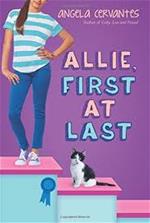 Fifth-grader Allie Velasco knows that everyone loves a winner, and in her particularly competitive family, she never measures up. In her eyes, winning first place in anything will validate her worth. Despite her best efforts, Allie simply never comes out on top in any competition she enters. When a special Trailblazer contest is announced, Allie knows the perfect subject for her entry—her great grandfather. But will her single-minded determination to win result in other losses, including her friendships with Sara and Victor? In the end, Allie rises to the occasion, does the right thing, and learns an important and unexpected lesson about what being a winner actually means. Leavened with plenty of humor and likeable, drawn-from-real-life characters, this book might help some students see themselves and competition in a different light.
Fifth-grader Allie Velasco knows that everyone loves a winner, and in her particularly competitive family, she never measures up. In her eyes, winning first place in anything will validate her worth. Despite her best efforts, Allie simply never comes out on top in any competition she enters. When a special Trailblazer contest is announced, Allie knows the perfect subject for her entry—her great grandfather. But will her single-minded determination to win result in other losses, including her friendships with Sara and Victor? In the end, Allie rises to the occasion, does the right thing, and learns an important and unexpected lesson about what being a winner actually means. Leavened with plenty of humor and likeable, drawn-from-real-life characters, this book might help some students see themselves and competition in a different light.
The Hero Two Doors Down: Based on the True Story of a Boy and a Baseball Legend. Sharon Robinson. 2016. Scholastic.
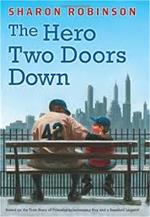 Baseball player Jackie Robinson was a hero both on and off the baseball field for many reasons, including breaking the sport’s color barrier. When the great player moves to the Brooklyn neighborhood of 8-year-old Stephen Satlow, a Jewish boy who idolizes Robinson and the Dodgers, everything changes. Although his parents try to keep him in line, sometimes Stephen finds it hard to avoid fighting, especially when dealing with school bullies. After Jackie befriends Steve and shows him alternatives to violence through example and quiet talk, the two families come to appreciate one another. Ideal for sharing as a read aloud, this book should prompt discussion about how to handle strife while also encouraging readers to learn more about Jackie Robinson and his life.
Baseball player Jackie Robinson was a hero both on and off the baseball field for many reasons, including breaking the sport’s color barrier. When the great player moves to the Brooklyn neighborhood of 8-year-old Stephen Satlow, a Jewish boy who idolizes Robinson and the Dodgers, everything changes. Although his parents try to keep him in line, sometimes Stephen finds it hard to avoid fighting, especially when dealing with school bullies. After Jackie befriends Steve and shows him alternatives to violence through example and quiet talk, the two families come to appreciate one another. Ideal for sharing as a read aloud, this book should prompt discussion about how to handle strife while also encouraging readers to learn more about Jackie Robinson and his life.
Once Upon a Frog (Whatever After #8). Sarah Mlynowski. 2016. Scholastic.
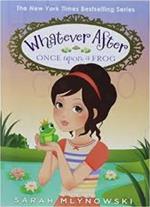 Sarah Mlynowski has a golden touch when it comes to revisionary fairy tales. In this latest book in Mlynowski’s popular fantasy series, Abby is annoyed by an insulting nickname used by Brandon, one of her classmates, and worried that her brother, Jonah, might be accessing the memories of Merryrose, their fairy tale benefactor. Accompanied by their dog, Prince, the siblings use the magic mirror in their basement to enter a fairy tale. Abby lands in a deep well with a frog named Frederic. As readers of The Frog Prince will quickly realize, this frog is not really an amphibian but a handsome prince who needs Abby’s help to reclaim his true identity. But the princess whose kiss could remove his spell is not very accommodating, and things are not what they seem on several levels. To her dismay, Abby learns that you cannot always trust a frog prince. Of course, everything works out in the end, with Abby returning home with an epiphany about the school bully who has been plaguing her.
Sarah Mlynowski has a golden touch when it comes to revisionary fairy tales. In this latest book in Mlynowski’s popular fantasy series, Abby is annoyed by an insulting nickname used by Brandon, one of her classmates, and worried that her brother, Jonah, might be accessing the memories of Merryrose, their fairy tale benefactor. Accompanied by their dog, Prince, the siblings use the magic mirror in their basement to enter a fairy tale. Abby lands in a deep well with a frog named Frederic. As readers of The Frog Prince will quickly realize, this frog is not really an amphibian but a handsome prince who needs Abby’s help to reclaim his true identity. But the princess whose kiss could remove his spell is not very accommodating, and things are not what they seem on several levels. To her dismay, Abby learns that you cannot always trust a frog prince. Of course, everything works out in the end, with Abby returning home with an epiphany about the school bully who has been plaguing her.
Saving the Whole Wide World (Hilo #2). Judd Winick. 2016. Random House.
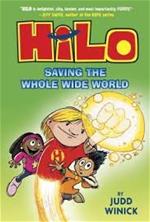 In this action-packed graphic novel, Hilo, a robot intent on doing good instead of bad, is faced with the challenging task of saving the world. Although the book deals with a heavy topic, it does so with grace and humor, particularly relating to Hilo’s naïve ways when it comes to Earthly matters. As the book opens, Hilo returns from another dimension and recruits his buddies D.J. and Gina to protect Earth from several strange and deadly creatures emerging from nearby portals. Although both friends are determined to help Hilo, Gina worries that Hilo will be unable to protect them. The youngsters are joined by Pollandra Pack Wallace Brimdale Korimako, a fierce and witty apprentice sorceress who savors the planet’s nutritional bounties while pretending not to. Readers will appreciate the imaginatively named creatures that arrive on Earth after Hilo: the hippo-like Slobberbacks, fast-growing and rapacious vegetation named Rapscallions, and the villainous Razorwark. The book ends on a cliffhanger, leaving readers gnashing their teeth in agony while eagerly awaiting the next installment. The book’s appeal rests on the normality of the human characters’ home and school lives, even while nestled within the science fiction aspect of the storyline.
In this action-packed graphic novel, Hilo, a robot intent on doing good instead of bad, is faced with the challenging task of saving the world. Although the book deals with a heavy topic, it does so with grace and humor, particularly relating to Hilo’s naïve ways when it comes to Earthly matters. As the book opens, Hilo returns from another dimension and recruits his buddies D.J. and Gina to protect Earth from several strange and deadly creatures emerging from nearby portals. Although both friends are determined to help Hilo, Gina worries that Hilo will be unable to protect them. The youngsters are joined by Pollandra Pack Wallace Brimdale Korimako, a fierce and witty apprentice sorceress who savors the planet’s nutritional bounties while pretending not to. Readers will appreciate the imaginatively named creatures that arrive on Earth after Hilo: the hippo-like Slobberbacks, fast-growing and rapacious vegetation named Rapscallions, and the villainous Razorwark. The book ends on a cliffhanger, leaving readers gnashing their teeth in agony while eagerly awaiting the next installment. The book’s appeal rests on the normality of the human characters’ home and school lives, even while nestled within the science fiction aspect of the storyline.
Ages 12–14
Endure (Defy #3). Sara B. Larson. 2016. Scholastic.
 In the last book of an action-filled fantasy trilogy, Alexa Hollen, the King's trusted guard, and King Damian are engaged to be married despite mutual trust issues. But before the couple has more than a minute to bask in each other's company, Alexa returns to the jungle to rescue her friend Rylan, who has been injured and imprisoned by the king’s enemies. Despite being captured and bled for the power her blood might provide to those allied against the kingdom of Antion, Alexa manages to return to her king just in time to save the kingdom. The ending is triumphant, heart-wrenching, and deeply satisfying, leaving readers pleased that the couple has survived with their love intact but also keenly aware of the cost of war and grateful to those whose sacrifices have made their happiness possible. Fans of the series will not be disappointed and might take to heart the book’s counsel to live each day to the fullest.
In the last book of an action-filled fantasy trilogy, Alexa Hollen, the King's trusted guard, and King Damian are engaged to be married despite mutual trust issues. But before the couple has more than a minute to bask in each other's company, Alexa returns to the jungle to rescue her friend Rylan, who has been injured and imprisoned by the king’s enemies. Despite being captured and bled for the power her blood might provide to those allied against the kingdom of Antion, Alexa manages to return to her king just in time to save the kingdom. The ending is triumphant, heart-wrenching, and deeply satisfying, leaving readers pleased that the couple has survived with their love intact but also keenly aware of the cost of war and grateful to those whose sacrifices have made their happiness possible. Fans of the series will not be disappointed and might take to heart the book’s counsel to live each day to the fullest.
Saving Wonder. Mary Knight. 2016. Scholastic.
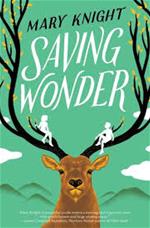 Wonder Gap, KY, is a coal mining town dependent on the coal mining industry for its economic well-being. But mining, particularly mountain top removal, is destructive to the environment and its animals. Twelve-year-old Curley Hines lives with his grandfather near Red Hawk Mountain. Curley's Papaw has plans for his grandson and wants him to have a better life than he might have if he stayed in the mountains. To that end, he's been keeping a secret about their finances and teaching Curley a new word each week, starting with a different letter each time. As Curley struggles with his feelings about the relationship between JD, the son of the new coal mine boss, and his best friend, Jules, he also faces a difficult choice that might mean leaving his beloved mountain sooner than he expected. Despite the difficulty of fighting against the system, Curley realizes that some things are worth saving, and he must use the words he’s been collecting all of his life to save the natural wonder around him.
Wonder Gap, KY, is a coal mining town dependent on the coal mining industry for its economic well-being. But mining, particularly mountain top removal, is destructive to the environment and its animals. Twelve-year-old Curley Hines lives with his grandfather near Red Hawk Mountain. Curley's Papaw has plans for his grandson and wants him to have a better life than he might have if he stayed in the mountains. To that end, he's been keeping a secret about their finances and teaching Curley a new word each week, starting with a different letter each time. As Curley struggles with his feelings about the relationship between JD, the son of the new coal mine boss, and his best friend, Jules, he also faces a difficult choice that might mean leaving his beloved mountain sooner than he expected. Despite the difficulty of fighting against the system, Curley realizes that some things are worth saving, and he must use the words he’s been collecting all of his life to save the natural wonder around him.
Ages 15+
The Possibility of Now. Kim Culbertson. 2016. Point/Scholastic.
 Those who fly high sometimes fall hard, and few have fallen as hard or as publicly as senior Mara James, who has nearly clinched the valedictorian title at her elite San Diego high school. But when the pressure to be perfect causes her to freak out during a calculus exam, a clip of that meltdown goes viral on YouTube. Unwilling to face the humiliation of returning to school, Mara flees to Squaw Valley, where her absentee father lives. Amid the beauty of nature and the resort’s own brand of competition, Mara tests herself in unexpected ways while trying to figure out what matters to her and getting to know her father. Eventually, Mara realizes that although planning for the future may be important, living in the now is also important. Many overscheduled and goal-oriented teens might recognize themselves in Mara, who finds that risks can lead to heartbreak but also possibilities. Sometimes getting off that endless treadmill, breathing, and savoring the possibilities of now is important.
Those who fly high sometimes fall hard, and few have fallen as hard or as publicly as senior Mara James, who has nearly clinched the valedictorian title at her elite San Diego high school. But when the pressure to be perfect causes her to freak out during a calculus exam, a clip of that meltdown goes viral on YouTube. Unwilling to face the humiliation of returning to school, Mara flees to Squaw Valley, where her absentee father lives. Amid the beauty of nature and the resort’s own brand of competition, Mara tests herself in unexpected ways while trying to figure out what matters to her and getting to know her father. Eventually, Mara realizes that although planning for the future may be important, living in the now is also important. Many overscheduled and goal-oriented teens might recognize themselves in Mara, who finds that risks can lead to heartbreak but also possibilities. Sometimes getting off that endless treadmill, breathing, and savoring the possibilities of now is important.
Smash & Grab. Amy Christine Parker. 2016. Random House.
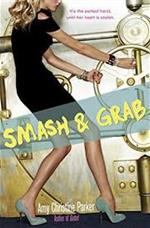 Lexi Scott likes taking risks such as zooming through the streets of Los Angeles on her motorcycle or base jumping from high buildings with her friends. When her father is arrested for bank fraud and the family’s financial assets are frozen, she sets out to discover the truth about who is behind the scheme and to get her life back on track. At the same time, Christian Ruiz, a smart boy with plans for college, is stuck helping to rob banks for a local gang to keep his family safe. When Lexi and Christian meet, sparks fly, but when they keep running into each other near the bank, they become suspicious of each other. In this story told from alternating viewpoints, readers will enjoy watching the two protagonists circle around each other, growing closer, moving farther apart, both longing for intimacy and yet afraid of letting go of their defenses even while planning a daring heist.
Lexi Scott likes taking risks such as zooming through the streets of Los Angeles on her motorcycle or base jumping from high buildings with her friends. When her father is arrested for bank fraud and the family’s financial assets are frozen, she sets out to discover the truth about who is behind the scheme and to get her life back on track. At the same time, Christian Ruiz, a smart boy with plans for college, is stuck helping to rob banks for a local gang to keep his family safe. When Lexi and Christian meet, sparks fly, but when they keep running into each other near the bank, they become suspicious of each other. In this story told from alternating viewpoints, readers will enjoy watching the two protagonists circle around each other, growing closer, moving farther apart, both longing for intimacy and yet afraid of letting go of their defenses even while planning a daring heist.
Barbara A. Ward teaches graduate and undergraduate courses in literacy at Washington State University, Pullman. She spent 25 years teaching in the public schools of New Orleans, where she worked with students at every grade level, from kindergarten through high school as well as several ability levels. She is certified in elementary education, English education, and gifted education. She holds a bachelor's in Communications, a master's in English Education from the University of Tennessee and a PhD in Curriculum and Instruction from the University of New Orleans.
These reviews are submitted by members of the International Literacy Association's Children's Literature and Reading Special Interest Group (CL/R SIG) and are published weekly on Literacy Daily.